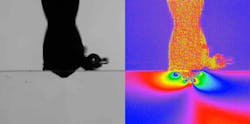High-speed polarization camera has monolithic photonic-crystal sensor
High-speed cameras enable us to understand the dynamics of processes including combustion, particle image velocimetry (PIV), and ballistics. But polarization can play a key role in revealing the internal stress mechanisms of the materials in question. While conventional polarization cameras typically use discrete optical filters to determine the retardation between the fast and slow axes for anisotropic materials, Photron (San Diego, CA) has developed its Crysta camera with a monolithic sensor that avoids the vibration/misalignment vulnerability of bulk optics.
The Crysta’s 1 Mpixel sensor includes a photonic crystal polarizer applied directly to the high-speed sensor with clusters of four 20 µm square pixels forming a “polarization pixel,” each having a different polarization axis, offset 45˚ from its neighbor, at 0˚, 45˚, 90˚, and 135˚. This 2D polarization sensor architecture, coupled to its high-speed parallel read-out analog-to-digital (A/D) converters, enables the light-sensitive sensor to provide 7000 frames-per-second (fps) polarization images, and over 1 million fps at reduced resolution, including retardation, polarization axis, and conventional monochrome high-speed data from a single camera.
Given the direct correlation between birefringent retardation and the stress in materials, the Crysta lets users see how stress is formed in high-speed dynamic detail. For example, images recorded by the Crysta from drilling an acrylic block at 1000 fps show the birefringent stress distribution. Tests like these enable engineers to adjust the cutting and drilling processes to minimize stress and resultant defects in finished products. Reference: https://photron.com/crysta-polarization-high-speed-camera.
About the Author

Gail Overton
Senior Editor (2004-2020)
Gail has more than 30 years of engineering, marketing, product management, and editorial experience in the photonics and optical communications industry. Before joining the staff at Laser Focus World in 2004, she held many product management and product marketing roles in the fiber-optics industry, most notably at Hughes (El Segundo, CA), GTE Labs (Waltham, MA), Corning (Corning, NY), Photon Kinetics (Beaverton, OR), and Newport Corporation (Irvine, CA). During her marketing career, Gail published articles in WDM Solutions and Sensors magazine and traveled internationally to conduct product and sales training. Gail received her BS degree in physics, with an emphasis in optics, from San Diego State University in San Diego, CA in May 1986.
